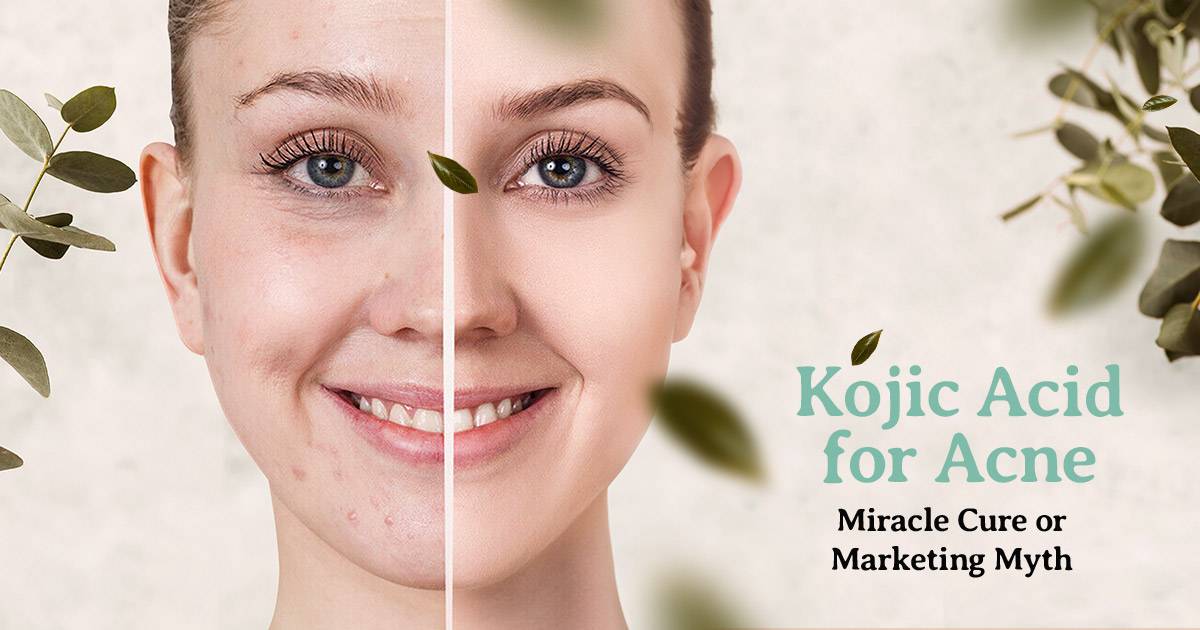Kojic Acid for Acne: Miracle Cure or Marketing Myth?

Acne is a relatively common skin condition that affects millions of people worldwide. It can be frustrating and difficult to treat, prompting many people to look into different skincare products and substances. Kojic acid is one of these ingredients that has grown in favor in recent years. But does kojic acid help with acne? Understand what kojic acid is, its benefits, how to use it, and potential side effects to help you determine if it’s the right choice for your skincare routine.
What is Kojic Acid?
Kojic acid is a natural compound generated from fungi, notably Aspergillus oryzae, often known as koji. It is a byproduct of the fermentation process that produces sake, soy sauce, and rice wine. Kojic acid is well-known for its skin-whitening qualities, and it is frequently used in skincare products to address hyperpigmentation, dark spots, and uneven skin tone.
Using kojic acid soap can offer several benefits for your skin:
- Lightening Dark Spots: Kojic acid effectively reduces the appearance of dark spots and hyperpigmentation, resulting in a more uniform skin tone.
- Brightening Skin: Regular use of kojic acid soap can help brighten your complexion and give your skin a healthy glow.
- Reducing Acne Scars: Kojic acid soap can help reduce the appearance of acne scars over time by lightening post-acne hyperpigmentation.
- Antibacterial Properties: The antibacterial properties of kojic acid can help reduce acne-causing bacteria, potentially preventing new breakouts.
- Antioxidant Protection: Kojic acid’s antioxidant properties can help shield your skin from free radicals and other environmental stressors.
How does kojic acid work?
Kojic acid reduces melanin production, the pigment responsible for skin color. It accomplishes this by blocking tyrosinase, an enzyme necessary for melanin synthesis. Kojic acid can help lighten black spots, age spots, and other types of hyperpigmentation by inhibiting melanin formation. This property makes it a popular ingredient in many skin-lightening and brightening products.
Does kojic acid help with acne?
While kojic acid is primarily known for its skin-lightening effects, it can also help acne. Here’s how:
- Reducing Post-Acne Hyperpigmentation: One of the main benefits of kojic acid for acne sufferers is its lightening post-inflammatory hyperpigmentation (PIH). PIH develops when dark patches appear on the skin after an acne lesion has healed. By lowering melanin production, kojic acid can help remove dark spots over time, resulting in a more even complexion.
- Antibacterial Properties: Kojic acid has been found to possess antibacterial properties, which can help reduce the bacteria responsible for acne breakouts. This can be particularly beneficial for those with acne-prone skin, as it may help prevent new pimples from forming.
- Antioxidant Effects: Kojic acid contains antioxidants that can protect the skin from free radical damage. Free radicals can contribute to inflammation and acne, so using products with kojic acid may help reduce acne-related inflammation.
How to use kojic acid soap?
Kojic acid soap is a popular way to incorporate this substance into your skincare routine. Here’s a step-by-step guide on how to use kojic acid soap effectively:
- Choose the Right Soap: Look for a kojic acid soap that is formulated for your skin type. Some soaps may contain additional ingredients, like glycerin or coconut oil to help moisturize the skin.
- Patch Test: Before using kojic acid soap on your face, perform a patch test on a small skin area to rule out any potential sensitivities.
- Wet Your Skin: Wet your face or the area where you plan to use the soap with lukewarm water.
- Lather the Soap: To create a lather, rub the soap between your hands.
- Apply to Skin: Gently massage the lather into your skin, avoiding the eyes. You should leave the soap on for a while so that the kojic acid can penetrate your skin.
- Rinse Thoroughly: To eliminate any remaining soap, thoroughly rinse your skin with lukewarm water.
- Moisturize: After using kojic acid soap, apply a gentle moisturizer to keep your skin hydrated.
Can you use kojic acid soap every day?
You can use kojic acid soap every day, but it’s best to begin slowly and watch how your skin responds. For some people, using it daily might cause dryness or irritation, especially if their skin is sensitive. Initially, use kojic acid soap every other day or every two days. If it works well with your face, slowly increase how often you use it. Use a moisturizer later to keep your skin from getting dry or irritated.
What are the side effects of kojic acid soap?
While kojic acid soap can offer many benefits, it’s important to be aware of potential side effects:
- Skin Irritation: Some people may experience skin irritation, redness, or itching when using kojic acid soap. If this happens, limit the frequency of use or quit it entirely.
- Dryness: Kojic acid soap can dry, particularly for sensitive or dry skin. After cleansing your skin, apply moisturizer to keep it hydrated.
- Photosensitivity: Kojic acid might make your skin more susceptible to sunlight. During the day, put on sunscreen to shield your face from UV rays.
- Allergic Reactions: In rare situations, kojic acid may induce allergic responses. If you experience severe itching, swelling, or hives, discontinue using the product and seek medical attention.
Kojic acid can be a good addition to your skincare routine
Kojic acid is effective in improving acne and skin tone. It comes from fungi and is used to brighten skin and reduce black spots. Besides enhancing appearance, it fights acne-causing bacteria and inflammation. Start slowly with kojic acid, watch your skin, and use moisturizer and sunscreen consistently. With patience and consistent application, you can develop clearer, healthier skin.
